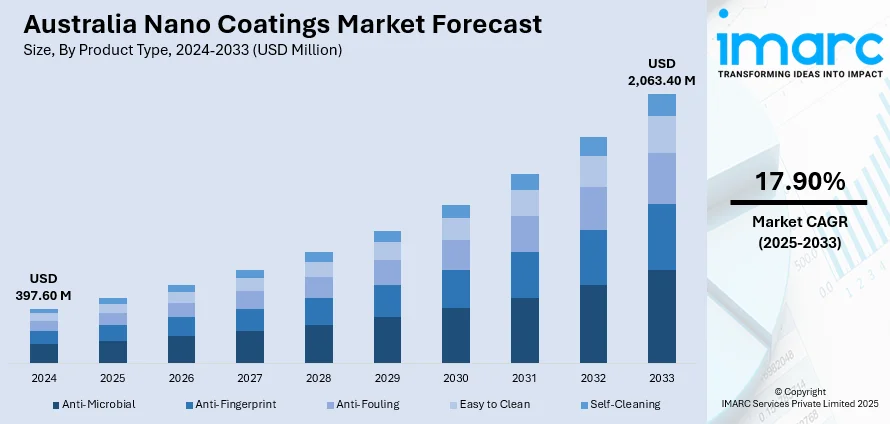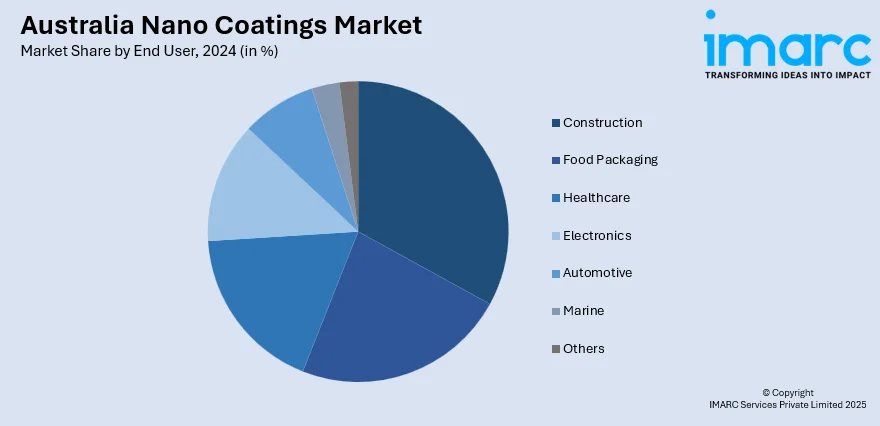
Australia Nano Coatings Market Size, Share, Trends and Forecast by Product Type, End User, and Region, 2025-2033
Australia Nano Coatings Market Overview:
The Australia nano coatings market size reached USD 397.60 Million in 2024. Looking forward, IMARC Group expects the market to reach USD 2,063.40 Million by 2033, exhibiting a growth rate (CAGR) of 17.90% during 2025-2033. Rising demand for advanced surface protection in sectors like automotive, construction, and electronics is propelling the market. Increased investments in R&D, coupled with growing awareness of eco-friendly alternatives, further stimulate the expansion of Australia nano coatings market share.
|
Report Attribute
|
Key Statistics
|
|---|---|
|
Base Year
|
2024
|
|
Forecast Years
|
2025-2033
|
|
Historical Years
|
2019-2024
|
| Market Size in 2024 | USD 397.60 Million |
| Market Forecast in 2033 | USD 2,063.40 Million |
| Market Growth Rate 2025-2033 | 17.90% |
Australia Nano Coatings Market Trends:
Increased Application in Renewable Energy Technologies
A notable trend in the Australia nano coatings market is the rising integration of nanocoating solutions in the renewable energy sector. Solar panels and wind turbines require protection against corrosion, moisture, and particulate accumulation. Nano coatings enhance efficiency by providing self-cleaning and anti-reflective properties, reducing maintenance costs and improving energy output. For instance, as per industry reports, researchers at the University of Sydney have developed nano-thin, biodegradable “liquid-like” coatings known as SCALS, offering self-cleaning, anti-adhesive properties without harmful PFAS chemicals. These coatings, just 2–5 nanometers thick, repel water, ice, and bacteria, and have potential in sustainable surface design. Their effectiveness is tied to precise nanoscale structuring. With Australia’s expanding solar infrastructure and governmental incentives for clean energy projects, there is heightened demand for advanced surface coatings that prolong the lifespan of renewable installations. Moreover, local manufacturers are increasingly incorporating nano-enabled materials to boost the performance of photovoltaic modules and related systems. This movement aligns with Australia’s commitment to sustainable technologies and contributes positively to the Australia nano coatings market growth, making energy applications a significant expansion segment.

To get more information on this market, Request Sample
Expansion in Smart Textiles and Wearable Technologies
The Australia nano coatings market is experiencing robust interest from the smart textiles and wearable technology sectors. With the evolution of functional fabrics, there is increasing demand for coatings that offer UV resistance, moisture control, and antimicrobial properties without compromising flexibility or comfort. Australian startups and research institutions are actively collaborating to produce next-generation wearable materials embedded with nano coatings that enhance durability and performance. Furthermore, military and healthcare applications are driving specialized development of coatings for uniforms, sensors, and medical garments. For instance, in 2025, Australia awarded $16.5 Million in Defence Industry Development Grants to 58 businesses, supporting over 200 skilled jobs. The program spans export, skilling, security, and sovereign industrial priorities, with four companies receiving $1 Million each for manufacturing components like rocket motors, submarines, and radar systems. Notably, DefendTex received $226,839 to acquire nano-coating equipment for robust robotics in guided weapons. The initiative offers 50% matching grants through 2028, strengthening Australia's sovereign defence capability, workforce skills, and advanced manufacturing technologies. As these innovations gain traction, they present lucrative commercial opportunities for coating manufacturers. The convergence of material science and nano-engineering in textiles underscores a transformative trend, reinforcing the trajectory of market growth across diversified end-user applications.
Australia Nano Coatings Market Segmentation:
IMARC Group provides an analysis of the key trends in each segment of the market, along with forecasts at the regional level for 2025-2033. Our report has categorized the market based on product type and end user.
Product Type Insights:
- Anti-Microbial
- Anti-Fingerprint
- Anti-Fouling
- Easy to Clean
- Self-Cleaning
The report has provided a detailed breakup and analysis of the market based on the product type. This includes anti-microbial, anti-fingerprint, anti-fouling, easy to clean, and self-cleaning.
End User Insights:

- Construction
- Food Packaging
- Healthcare
- Electronics
- Automotive
- Marine
- Others
A detailed breakup and analysis of the market based on the end user have also been provided in the report. This includes construction, food packaging, healthcare, electronics, automotive, marine, and others.
Regional Insights:
- Australia Capital Territory & New South Wales
- Victoria & Tasmania
- Queensland
- Northern Territory & Southern Australia
- Western Australia
The report has also provided a comprehensive analysis of all the major regional markets, which include Australia Capital Territory & New South Wales, Victoria & Tasmania, Queensland, Northern Territory & Southern Australia, and Western Australia.
Competitive Landscape:
The market research report has also provided a comprehensive analysis of the competitive landscape. Competitive analysis such as market structure, key player positioning, top winning strategies, competitive dashboard, and company evaluation quadrant has been covered in the report. Also, detailed profiles of all major companies have been provided.
Australia Nano Coatings Market News:
- In December 2024, Kaltra introduced an advanced nanoscale coating for aluminum microchannel heat exchangers, enhancing corrosion resistance and durability while preserving thermal efficiency. The coating, under 5µm thick, offers UV protection, hydrophobicity, and a smooth surface that reduces pressure drops. Tested on different aluminum alloys, it extended operational life and widened fluid compatibility and temperature ranges. This innovation improves heat exchanger performance, energy efficiency, and versatility across applications.
- In February 2024, IGL Coatings announced its expansion across Australia, enhancing access to its ceramic nanocoating products for automotive, industrial, and commercial sectors. Partnering with top local businesses, the company aims to strengthen distribution, training, and support. Its eco-friendly nanotechnology aligns with sustainability goals, reinforcing Australia nano coatings market growth.
Australia Nano Coatings Market Report Coverage:
| Report Features | Details |
|---|---|
| Base Year of the Analysis | 2024 |
| Historical Period | 2019-2024 |
| Forecast Period | 2025-2033 |
| Units | Million USD |
| Scope of the Report |
Exploration of Historical Trends and Market Outlook, Industry Catalysts and Challenges, Segment-Wise Historical and Future Market Assessment:
|
| Product Types Covered | Anti-Microbial, Anti-Fingerprint, Anti-Fouling, Easy to Clean, Self-Cleaning |
| End Users Covered | Construction, Food Packaging, Healthcare, Electronics, Automotive, Marine, Others |
| Regions Covered | Australia Capital Territory & New South Wales, Victoria & Tasmania, Queensland, Northern Territory & Southern Australia, Western Australia |
| Customization Scope | 10% Free Customization |
| Post-Sale Analyst Support | 10-12 Weeks |
| Delivery Format | PDF and Excel through Email (We can also provide the editable version of the report in PPT/Word format on special request) |
Key Questions Answered in This Report:
- How has the Australia nano coatings market performed so far and how will it perform in the coming years?
- What is the breakup of the Australia nano coatings market on the basis of product type?
- What is the breakup of the Australia nano coatings market on the basis of end user?
- What is the breakup of the Australia nano coatings market on the basis of region?
- What are the various stages in the value chain of the Australia nano coatings market?
- What are the key driving factors and challenges in the Australia nano coatings market?
- What is the structure of the Australia nano coatings market and who are the key players?
- What is the degree of competition in the Australia nano coatings market?
Key Benefits for Stakeholders:
- IMARC’s industry report offers a comprehensive quantitative analysis of various market segments, historical and current market trends, market forecasts, and dynamics of the Australia nano coatings market from 2019-2033.
- The research report provides the latest information on the market drivers, challenges, and opportunities in the Australia nano coatings market.
- Porter's five forces analysis assist stakeholders in assessing the impact of new entrants, competitive rivalry, supplier power, buyer power, and the threat of substitution. It helps stakeholders to analyze the level of competition within the Australia nano coatings industry and its attractiveness.
- Competitive landscape allows stakeholders to understand their competitive environment and provides an insight into the current positions of key players in the market.
Need more help?
- Speak to our experienced analysts for insights on the current market scenarios.
- Include additional segments and countries to customize the report as per your requirement.
- Gain an unparalleled competitive advantage in your domain by understanding how to utilize the report and positively impacting your operations and revenue.
- For further assistance, please connect with our analysts.
 Request Customization
Request Customization
 Speak to an Analyst
Speak to an Analyst
 Request Brochure
Request Brochure
 Inquire Before Buying
Inquire Before Buying




.webp)




.webp)












